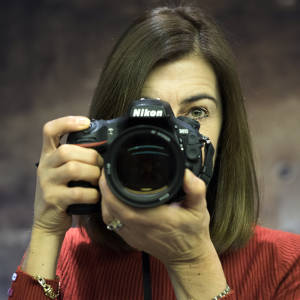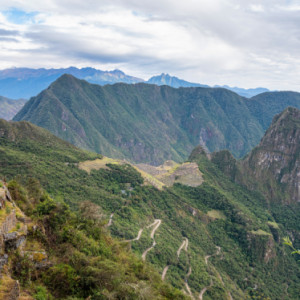Peru - Machu Picchu
Thank you so much for the lovely comments, stars and hearts on yesterday’s image, I really appreciate them. Sorry I have not had time to reply to comments, it has been so busy on this trip.
We were at breakfast by 6.30am as our guide was collecting us at 7am to walk from Machu Picchu up to Itipunku (the Sun Gate) which is situated 800m above the settlement. It was quite a hike up there, climbing stone steps up the Incan path, but the views from there were wonderful, looking down on to Huayna Picchu and the settlement. (The name Machu Picchu actually refers to the mountain behind the settlement and not the settlement itself) Coming down was much easier! I have added an extra of the view from there and the trail down. You can also see the road snaking up the mountain that the bus takes. When we got back down we walked the narrow path to see the Incan bridge. The path leading there was hewn into the rock and supported from below by a stone wall built into the cliff face, overlooking a sheer 600m drop. The engineering of this path, and the bridge, is simply mind blowing. Our guide was so knowledgeable and made it so interesting, the boys did not leave his side as they did not want to miss anything he said! My blip is of the view when walking to this bridge - being in the cloud forest the mountains are very green and I liked the colours here.
Back to the hotel for an early lunch as we had to get the train back to Ollantaytambo. The food was just amazing - a buffet of salads and traditional Peruvian foods that were so tasty. I have loved the food here, it suits my gluten intolerant diet with products like quinoa, corn and of course all the fresh fish. All of it is local produce and therefore ethically sourced which is a good thing. I had the best tasting gluten free corn bread at breakfast today, and at lunch time had a delicious quinoa salad with beans from the lupin flower. Peru gets my vote for the best food from any country that we have visited!
The train ride back was on a train with huge glass windows on the sides and in the roof so it was a very scenic journey. Some people have asked why we did not do the Inca Trail trek up to Machu Picchu. The trek has to be booked about a year in advance as only 400 people per day are admitted - this includes tourists, Sherpas and guides. You cannot do the trail without a guide. The trek takes 4 days and if you want to spend time at Machu Picchu you then really need almost a week to do this. We did not have the time to do the trek, preferring to go by train and spending two days exploring the site.
We were collected by the driver in Ollantaytambo and we were driven to the Inkariy Museum near Urubamba which showcases the major civilisations that formed Peru. It was really interesting and helps to explain who the Incas were.
It was a long day and we finally got back to our hotel by 6pm where we said a sad goodbye to our wonderful guide. Tomorrow is an awful day, we say goodbye to Peru as we move on to the next leg of our journey. We are being picked up at 4.15am to be taken to Cusco. We fly from Cusco back to Lima, hang around for a few hours in the airport before we connect to Quito, Ecuador - so it will mainly be a day of travelling.
You may not be interested in the next bit.....
What follows now is Adam's thoughts on the Incas, which I want to record in my journal as we have had so much information on them over the past few days and we all agree on this theory of their history ...
'The pre-Columbian South Americans were actually ridiculously advanced in the fields of agriculture, earth science, astronomy, and architecture. Their walls have survived centuries of earthquakes. Modern reconstructions of the ancient Cusco walls come nowhere close. The narrative that Incans were primitive tribal people who were overpowered by the Spanish is bollocks. Much more likely is that the Incans welcomed the Spanish with open arms, unaware that they were carrying European diseases to which the Incans had no immunity (smallpox, influenza etc). This ultimately led to the demise of the Incan civilisation and the tragic loss of their advanced technologies. Accelerating this loss of ancient technology and knowledge was the melting of Incan metal by the Spanish and the burning of Incan written records in Cusco to fuel these melting pots, or, more sinisterly, to eradicate Incan historical records so that the Spanish could write their own version of events in order to justify their terrible human rights violations, as was written by one Jesuit missionary in the late 1500s.
Furthermore, the habit of archaeologists to assume that megalithic sites are primarily religious in function is just bull****. It is arrogant to assume ancient civilisations were simple minded people who worshipped “the sun god” etc, especially when evidence suggests that these civilisations were advanced in astronomy. One more thing: civilisations are way older than conventional 20th Century archeologists describe. Ceramic remains have been found in Cusco from 1000 BC, and elsewhere in Peru from 3000 BC, but we are told the Incans were 1400s-1500s AD. The “Incan” city of Cusco is clearly much older. Ancient civilisations are a fascinating mystery that we may never get to solve!'



Comments
Sign in or get an account to comment.


